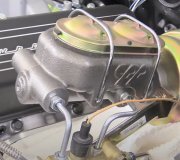Hi,
If the brake pedal goes to the floor, first make sure there are no hydraulic leaks in the brake system. Make sure the brake fluid reservoir is full. If it is, chances are the brake master cylinder is bad.
Take a look through this link:
https://www.2carpros.com/articles/brake-pedal-goes-to-the-floor
If you find the master cylinder is bad, replacing it isn't too hard of a job. When you get the replacement part, make sure it has a lifetime warranty. That way, you'll never have to pay for it again.
First, here is a link that shows how in general one is replaced. You can use this as a guide.
https://www.2carpros.com/articles/how-to-replace-a-brake-master-cylinder
The new brake master cylinder will need bench bled before install. Here is a video that shows how that is done:
https://youtu.be/WDxvEQrMkBg
Here are directions specific to your vehicle. The attached pics below correlate with the directions.
BRAKE MASTER CYLINDER
Brake Master Cylinder
NOTE: Automatic transmission shown, manual transmission similar.
NOTE: Non-hybrid vehicle shown, hybrid vehicle similar.
Removal and Installation
WARNING: Do not use any fluid other than clean brake fluid meeting manufacturer's specification. Additionally, do not use brake fluid that has been previously drained. Following these instructions will help prevent system contamination, brake component damage and the risk of serious personal injury.
WARNING: Carefully read cautionary information on product label. For emergency medical information seek medical advice. For additional information, consult the product Material Safety Data Sheet (MSDS) if available. Failure to follow these instructions may result in serious personal injury.
NOTICE: Do not spill brake fluid on painted or plastic surfaces or damage to the surface may occur. If brake fluid is spilled onto a painted or plastic surface, immediately wash the surface with water.
1. Remove the brake fluid reservoir. For additional information, refer to Brake Fluid Reservoir See: Brake Fluid Reservoir > Removal and Replacement > Brake Fluid Reservoir.
2. If equipped with a manual transmission, disconnect the clutch master cylinder feed hose.
- Plug the clutch master cylinder feed hose.
3. Disconnect the brake master cylinder brake tube fittings, plug the brake tubes and the brake master cylinder ports.
- Non-hybrid vehicles: To install, tighten to 28 Nm (21 lb-ft).
- Hybrid vehicles: To install, tighten to 20 Nm (177 lb-in).
4. NOTICE: Use only hand tools to remove and install the fasteners or damage to the booster may occur.
Remove the 2 brake master cylinder nuts.
- To install, tighten to 20 Nm (177 lb-in).
5. Remove the brake master cylinder.
6. NOTICE: Do not allow the flexible portion of the brake tubes to twist during installation, or damage to the brake tubes may occur.
To install, reverse the removal procedure.
- Bleed the master cylinder. For additional information, refer to Section 206-00 See: Brakes and Traction Control > Mechanical > Brake System - General Information.
- If equipped with a manual transmission, bleed the clutch master cylinder. For additional information, refer to Manual Transmission/Transaxle &/or Clutch, M/T.
7. To install, reverse the removal procedure.
- If a new brake master cylinder has been installed, bleed the master cylinder. Refer to Component Bleeding.
- If the brake master cylinder was removed to access other components, bleed the brake system. Refer to Brake System Bleeding.
8. If equipped with a manual transmission, bleed the clutch master cylinder. For additional information, refer to Manual Transmission/Transaxle &/or Clutch, M/T.
Check out the diagrams (Below). Let us know what happens and please upload pictures or videos of the problem.
Images (Click to make bigger)
Friday, March 12th, 2021 AT 10:42 PM



















